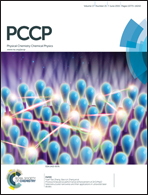Influence of halogen substitutions on rates of charge tunneling across SAM-based large-area junctions†
Abstract
This paper examines the ability of structural modifications using halogen atoms (F, Cl, Br, and I) to influence tunneling rates across self-assembled monolayer (SAM)-based junctions having the structure AgTS/S(CH2)n(p-C6H4X)//Ga2O3/EGaIn, where S(CH2)n(p-C6H4X) is a SAM of benzenethiol (n = 0) or benzyl mercaptan (n = 1) terminated in a hydrogen (X = H) or a halogen (X = F, Cl, Br, or I) at the para-position. The measured tunneling current densities (J(V); A cm−2) indicate that replacing a terminal hydrogen with a halogen atom at the X//Ga2O3 interface leads to a decrease in J(V) by ∼×13 for S(p-C6H4X) and by ∼×50 for SCH2(p-C6H4X). Values of J(V) for the series of halogenated SAMs were indistinguishable, indicating that changes in dipole moment and polarizability caused by introducing different halogen atoms at the interface between the SAM and the Ga2O3/EGaIn electrode do not significantly influence the rates of charge tunneling across the junctions.


 Please wait while we load your content...
Please wait while we load your content...